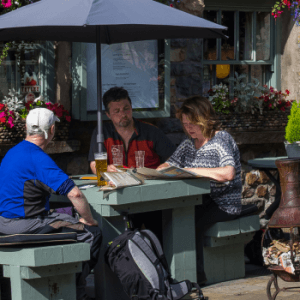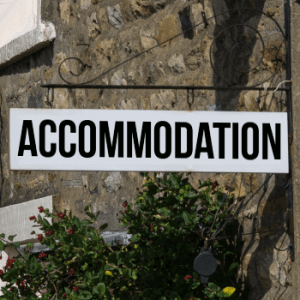Click here to download a pdf of this walk
Distance: 3.7 km (2.3 miles)
Time: 60 – 90 minutes.
Moderate walking, some uphill, good views if the weather is clear, good birdlife.
A good walk with children – unkempt woods and picnic spots by the river. Not suitable for prams, buggies or wheelchairs.
A popular dog walk but there may be sheep in the fields around the Pepperpot, and cows or sheep on the riverbank.
May be muddy in places.
(1) Start at Sedbergh Information Centre at 72 Main Street, turn right along Main Street and at the end turn left down Finkle Street past the church. Turn right just past the churchyard and follow the narrow lane along the side of the cricket pitch. You are now in the grounds of Sedbergh School. Turn left at the wooden finger post, signposted to Birks. Follow this path past the cricket pavillion, through a gate and down the grassy hill (sometimes muddy) to Busk Lane (as you start to go downhill, look back to your right and you will see the Sedbergh School Cloisters). Cross the road (Busk Lane).
(1a) Alternatively do not turn right off Finkle Street but instead continue straight on up Loftus Hill. Turn right into Busk Lane and continue to the bottom of the hill. Pink route on map.
(2) Follow the tarmac roadway which runs between playing fields and the Hirst Centre, Sedbergh School’s sports centre. Continue past a large barn, then steeply downwards on the path straight ahead. Just past the righthand bend go through a small metal kissing gate a bit tucked away on the left. This section can be very muddy. Take a few minutes to observe the wildlife on the Bruce Loch Nature Reserve
(3) Bear left around the south side of the reserve and uphill to a break in a stone wall. On top of the hill in front of you is a building known locally as the Pepperpot. This was originally a kind of stone gazebo belonging to Akay House, which once stood in the woods ahead of you. Some people say the Pepperpot was built for a daughter of the house who suffered from TB. There is an information board here.
Continue past the Pepperpot to a bench at the corner of the wood, a good place to rest while enjoying views of Sedbergh with Winder fell behind. Carry on with the Millennium Wood on your left to a kissing gate on your right.
(4) Go through the gate into Akay Wood. The direct path through follows the footpath signs. However it is worth spending some time exploring the woods, which at different times of year are full of snowdrops, bluebells and ransomes (wild garlic). Here is a suggested route (blue on the map):
- Go through the kissing gate into the wood then turn immediately right and take the central path to the top of the steep bank above the river (take care with small children here). Swing left round the corner of an old wall and follow the path high above the river until you approach a fence.
- Turn left uphill before the fence, then at the top of the hill turn right to cross between sunken walls on each side of the path. To the right see if you can find a piece of tiled floor, part of the house which was demolished in 1938.
- At the footpath marker post do not follow the arrow. Instead take a broad path which forks leftwards following the old driveway to reach three large stone gateposts, the original entrance to the property.
- Go through the gateposts and after a short distance turn right towards a sports field. Just in front of you is the Akay Oak, surrounded by a wooden fence. This noble tree is nearly 700 years old and, although it has lost many of its branches, is still very much alive.
- Retrace your steps into Akay Wood and then turn left along a narrow path towards some very prominent tall redwood trees. Walk between the redwoods to meet the main path coming down through the woods and turn left.
(5) You will come to a small gate at the edge of the wood, after which the path continues across a field. The buildings on your right are renovated buildings that belonged to Millthrop Mill, once a woollen mill. At the end of the field you can glimpse the beautiful old Millthrop Bridge before going through a gate and down some steps onto the Dent road.
(6) Turn right over the bridge, pausing in the triangular alcove to look down at the water swirling below. At the far side of the bridge turn left through a small gate onto the riverside path (signpost to New Bridge). Immediately on your left is a shingle beach, a popular area for picnics and for children to play beside the river. Further on you will come to the weir, another popular picnic spot. In late autumn you can sometimes see salmon leaping up the weir. The weir creates a large pool which used to feed the mill leat for Millthrop Mill. You can see the old sluice gate in the far bank, about 50m above the weir.
(7) When you come to New Bridge go through a metal gate, up the stone steps to the road and over the bridge back towards Sedbergh. After the bridge go through the gate on the left, at the back of the layby. This brings you to the picnic area where there are wooden tables and good access to the river. Now take the path on the right, which runs along the side of Settlebeck School sports field, to reach a car park. Walk left around the car park to the Millennium Stone, designed by the school students. Bear left here, walk along the narrow lane at the back of the school buildings, through two narrow gaps in old stone walls and past the Old Vicarage. Follow the wide track to the corner. Ahead you will see the Sedbergh Community Orchard.
(8) At the corner turn right and follow Vicarage Lane back into town. If you want to return to Main Street cross Back Lane at the zebra crossing, turn left and after a short distance turn right under an archway to walk through The Folly, one of Sedbergh’s ancient yards. You will emerge on Main Street opposite Sedbergh Information Centre.














